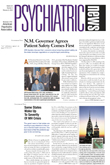This article is part of a series on what psychiatrists can do to ensure they are practicing in a safety-conscious manner.
Psychoactive medications have become the centerpiece for psychiatrists in the treatment of mental illness. Prescribing medications is such a routine activity that it is easy to lose sight of basic risk management strategies that can help improve patient care and minimize medication-related adverse events.
Most lawsuits against psychiatrists include allegations involving medications, and many of those lawsuits involve preventable medication events. APA and other national organizations have undertaken sweeping efforts to raise awareness of and reduce adverse medication events and, thereby, increase patient safety.
APA’s Committee on Patient Safety has taken the lead in such initiatives for psychiatry. (“The APA Task Force on Patient Safety: Recommendations to the APA Board of Trustees” is posted online at www.psych.org/pract_of_psych/apa_patientsafety_toc21003.pdf.)
The five steps of the risk management process can help improve patient safety. This process is applied here to identifying, analyzing, and minimizing preventable adverse medication events.
Step 1: Identify Current and Potential Risks
Data from psychiatric malpractice lawsuits reveal that adverse medication events are a frequent identifiable cause of lawsuits. Even when a medication-related event is not the basis for the lawsuit, some form of medication misadventure often appears in the facts of the case. A review of cases and risk management consultations handled recently by Professional Risk Management Services Inc., manager of the APA-endorsed Psychiatrists’ Professional Liability Insurance Program, found the following areas of risk related to adverse medication events:
• Lack of adequate patient assessment
• Failure to obtain and/or monitor laboratory test results
• Failure to address multiple positive toxicology screens for drugs of abuse
• Changing medications without consulting with or notifying other treating physicians
• Rapidly starting and stopping antipsychotic medications or making large dosage adjustments resulting in neuroleptic malignant syndrome
• Polypharmacy that increased adverse interactions
• Issues with complimentary/alternative medicines
• Written errors and altered or forged prescriptions
Step 2: Evaluate Risks (Frequency and Severity)
Adverse medication events are a high frequency/high severity risk, according to information from psychiatric malpractice lawsuits. Medication misadventures appear in half or more of the psychiatric malpractice suits reviewed for this article.
Step 3: Choose a Risk Management Strategy
Easily implemented risk-reduction strategies should be immediately targeted where they will have the most impact.
• Assess patients and monitor laboratory test results: Put in place a process for obtaining and documenting appropriate baseline laboratory testing and for making sure that follow-up testing is completed and reviewed. Obtain a comprehensive patient history and any necessary examinations before prescribing medications. See patients at clinically appropriate intervals.
• Assess patients for substance abuse issues: Remain aware of the potential for misuse and abuse of medications. Make appropriate treatment assessments and referrals for addiction and dependence issues. Be aware that patients might be altering prescriptions or “doctor shopping.” Document the dosage and size of all prescriptions and the frequency of prescription-renewal requests in an easily accessible format.
• Communicate with the patient: Educate patients about medication instructions, including the dose and frequency, ways to identify side effects, and what to do in the event of side effects or a bad reaction. Inquire about other medications the patient takes. Remind the patient to report any changes in medications or any new medications prescribed by another physician, including over-the-counter medications, herbal remedies, dietary supplements, and other treatments the patient uses. Regularly discuss with patients their compliance with the given instructions.
• Communicate with other treatment providers: Communicate with other physicians about all the medications that are being prescribed and about signs, symptoms, and responses to the medications.
• Obtain consultation from an experienced colleague: Obtain professional consultation or a referral to a physician with specialized training and expertise when appropriate.
• Handwriting and prescription pads: Writing on prescription forms and drug orders must be legible. Consider writing in numerals and in longhand, as on a check. Use tamper-resistant prescription pads with security devices. Store prescription pads in a secure place when not in use.
• Stay current on medication information: Participate in continuing education programs. Educate yourself through discussion with colleagues and through relevant literature. Review drug-manufacturer alerts.
Step 4: Implement the Strategy
It is not necessary to try to change everything at once. Start with selected strategies that have the most potential to impact the most significant patient-safety issues identified. Focus on improving systems and processes that support patient safety.
Computerization offers great potential to reduce adverse medication events. Appropriate computer programs may be used to type and transmit prescriptions, access the latest information, communicate securely with others, promptly follow up on laboratory tests and results, and provide alerts about potential medication interactions.
Step 5: Evaluate the Strategy
After a reasonable trial, decide whether the chosen strategy works, then modify it or implement another strategy as needed. Share your efforts with colleagues. ▪
